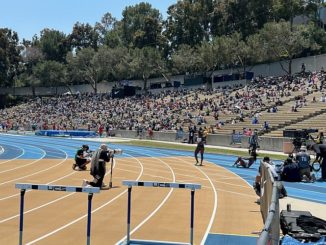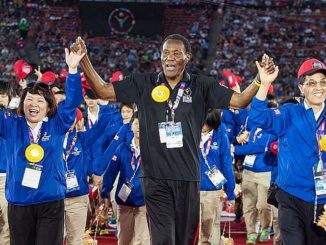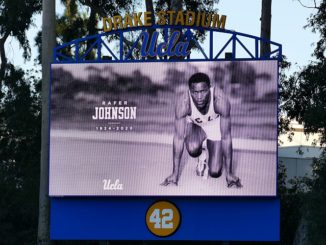
● From our sister site, TheSportsExaminer.com ●
“California’s Football Bowl Subdivision football players and Division I men and women basketball players are predominantly Black, and are the only college athletes in the state who do not receive at least 50 percent of the revenue that they produce.”
That’s from the preamble to California Senate Bill 1401, the “College Athlete Race and Gender Act,” introduced by Stephen Bradford (D-Gardena) and which would have colleges and universities pay their athletes directly about whatever is realized from their name, image and likeness.
It would likely have the effect of collapsing many of the university athletic programs in the state, including at UCLA, USC, Stanford and Cal, as well as most (if not all) of programs in the California State University system. It includes:
● Every “institution of higher learning” in the state will be required to “establish a degree completion fund” for all athletes at the school, payable to the athlete if he or she earns their Bachelor’s Degree within six years of enrolling.
● “The amount deposited into a student athlete’s degree completion fund … shall be determined by subtracting the amount of grant-in-aid athletic scholarships offered in the student athlete’s sport from 50 percent of the athletic program’s revenue for that individual sport. The difference shall be divided among each student athlete in that sport. The resulting quotient shall be allocated to the student athlete’s degree completion fund.”
● Each “athlete shall have immediate access to funds in their degree completion fund of up to twenty-five thousand dollars ($25,000) per academic year.”
For football, this will result in some money for the players, which is Bradford’s intent. It will result in something for men’s basketball players, maybe for women’s basketballers and little or nothing for everybody else.
Checking the Equity in Athletics Database, a U.S. Department of Education program in which many universities often lie about their athletics finances, but is a general barometer of revenues and expenses, what does this mean for, say, UCLA and USC from reports from the last pre-Covid year of 2019?
At UCLA (as reported):
● Total revenue: $119,391,431
● Total expenses: $119,391,431
● Football revenue: $37,548,589 (128 players)
● Basketball revenue/men: $11,036,275 (15)
● Basketball revenue/women: $902,912 (26)
● Track revenue/men: $197,019 (121)
● Track revenue/women: $199,666 (159)
Taking 50% of the revenue and then subtracting the cost of grants-in-aid would leave essentially nothing in every sport except football and men’s basketball. For football, 50% of the 2019 revenue at UCLA was $18,774,294, and when divided among 128 players, is $146,674 per player, out of which the scholarship cost must be deleted.
UCLA states that its costs for in-state enrollees for tuition, fees, room and board is $36,172, but for out-of-state enrollees – and there are a lot of those – the cost goes to up to more than $64,000. Even so, the football players make out, with about $110,000 for in-state players and maybe $82,000 for out-of-state players.
For men’s basketball, UCLA takes in $11 million, so half of that is $5.5 million, divided among just 15 players. That’s $366,667 each, a bonanza (and a serious tax problem for what are now professional players).
But what about women’s basketball? UCLA’s women’s program took in a paltry $902,912 and has 26 players listed (even though the limit is 15). So, 50% of that revenue is $451,456 and if divided by the 15-player limit, is $30,097, which doesn’t even cover the scholarship costs.
Same for all the other sports. Even the popular women’s gymnastics program grossed only
$991,693 in 2019. Half of that is $495,847 and with 22 athletes, the average is $22,538, not even close to the cost of a full (or partial) scholarship.
Where’s the $25,000 a year supposed to come from for the 738 out of 881 student-athletes at UCLA who aren’t men’s football or basketball players?
Looking at the preamble to his bill, Bradford doesn’t care; only players in the “predominantly Black” sports of football and basketball matter.
UCLA’s situation as a major state university is similar to its private, crosstown neighbor, USC:
At USC (as reported):
● Total revenue: $127,801,994
● Total expenses: $127,801,994
● Football revenue: $53,380,160 (118 players)
● Basketball revenue/men: $6,540,372 (15)
● Basketball revenue/women: $2,952,488 (12)
● Track revenue/men: $901,282 (39)
● Track revenue/women: $925,023 (34)
USC is a private school and costs a lot more than UCLA; its estimate is $77,459 annually, including tuition, fees, room and board and transportation.
Still, the football players will get paid, as 50% of the 2019-year revenue is $226,187, or $149,128 above the cost of tuition.
Men’s basketball? Half of the USC men’s revenue is $3,270,186 and divided by 15 players is $218,012, or about $140,553 after the scholarship cost. Not UCLA money, but still pretty good.
Women’s basketball? Their 50% revenue share is $1,476,244 or $123,020 among 12 players or $45,561 after scholarships costs.
Almost all of the other USC athletes would get nothing above their scholarships, depending on the squad size.
For California universities in the Pac-12 Conference or the Mountain West Conference – Fresno State and San Diego State – such a bill would require huge infusions of cash from the universities themselves and a major cutback in sports. The NCAA – it’s still around – requires 14 sports with at least six for men and eight for women to be in Division I, but how is that possible if most sports make nothing and their financial support from the surpluses of the football and men’s basketball programs disappear?
And where does Title IX and “women’s equity” fit in?
How long before pressure builds to just eliminate athletics altogether and just license the school names and mascots to a professional U-23 league for football and basketball only?
The bill has been passed out of the Senate Education Committee on 20 April and out of the Senate Judiciary Committee on 26 April. It’s next headed to the Appropriations Committee. It has not been introduced in the State Assembly.
As U.S. college sport continues to spin out of control, the reality is widely predicted to be a super-league of the Big 10 and SEC schools, who have the most money, and some sort of other group of formerly big-time schools from the Atlantic Coast Conference, Big XII and Pac-12, and then everyone else.
Or is football completely separated and professionalized so that the NCAA basketball tournament is maintained? In every case, the Olympic-focused sports are the big, big losers.
¶
Sportico reported on a different but also potentially game-changing concept from the U.S. armed forces, taking advantage of the continuing uncertainty in collegiate sport:
“The U.S. military is actively discussing an initiative, proposed by a defense contractor, to fund athletic scholarships for tens of thousands of college athletes each year in exchange for their mandatory service.”
This would not involve football or basketball, but concentrate on all of the other sports – mostly Olympic-focused – which stand to be imploded with the continuing rush to pay revenue-sport athletes.
The idea apparently came from former Auburn runner Dave Maloney, who leads Houston-based Orchestra Macrosystems, an Air Force contractor. His proposal would essentially offer scholarships to athletes at all college levels in return for post-graduate service.
The military’s new budget has $1.32 billion for recruitment, compared to Sportico’s estimate of $653 million in scholarship spending – outside of football and basketball – by the 131 Football Bowl Subdivision schools.
The American military already has the World Class Athlete Program (WCAP), focused on post-collegiate athletes such as distance star Paul Chelimo, who are also full-time soldiers.
If California SB 1401 passes, and spreads, concepts like this may be the savior of collegiate sport, or the start of an entirely new, sport-by-sport concept. This bears close watching.
~ Rich Perelman




Be the first to comment